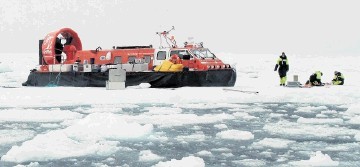
This summer, a hovercraft will set out on a research voyage from Svalbard to the North Pole in the first and northernmost polar expedition undertaken by such technology.
The Norwegian Petroleum Directorate-sponsored expedition will set a new record for polar exploration.
According to its senior geologist Harald Brekke, never before has there been a Norwegian scientific expedition so far north.
“Not even Nansen or Amundsen made it this far,” he said at the project’s launch.
Over the past four summers, the 12m by 6m (40ft by 20ft approx) hovercraft Sabvabaa (Greenlandic for “floats quickly over”) has being acquiring data in the areas north of the ice edge near Svalbard.
Until now, only icebreakers could be used so close to the North Pole. However, global warming means that it is possible to use a hovercraft . . . if conditions are as mild as expected this summer.
According to the NPD, an icebreaker consumes as much diesel during the course of a day as the hovercraft consumes over five months, and an icebreaker largely has to follow the channels in the ice, while a hovercraft can move freely over the ice surface.
Between July and September this year, Sabvabaa will be used for activities such as mapping the geology in the submarine Lomonosov Ridge in the far north of the Arctic Ocean, which extends across the entire Arctic Ocean from Russia to Greenland and Canada, and was formed 65million years ago
The NPD is providing financial support for the expedition, while the University of Bergen and the independent research institute, the Nansen Centre, are contributing equipment and personnel. The expedition, christened “Fram 2012”, will be led by Professor Yngve Henriksen.
In addition to measuring the thickness of the sea ice, the Sabvabaa will acquire seismic data and take geological samples from the seabed. According to Brekke, much of the bedrock on the northernmost edge of the Barents Sea shelf has eroded over time. However, it is assumed that these rocks have been preserved in the Lomonosov Ridge.
“If we are to understand what was once there, we have to know as much as possible. Geological samples from the Lomonosov Ridge can therefore tell us what happened in the Barents Sea,” he said, adding that it is also interesting for the NPD to test the equipment, with a view towards using it on other mapping assignments in the north.
The mapping of the Lomonosov Ridge is also interesting in terms of maritime law. The UN’s Law of the Sea Convention gives coastal states the right to demand extension of their economic zone, based on geological criteria, to delimit the individual countries’ continental shelves.
All such demands for expansion must be documented with geological or geophysical data.
In 2001 and 2005, the NPD chartered the Swedish icebreaker Oden to acquire documentation for the Norwegian demand to set the border of the Continental Shelf outside 200 nautical miles north of Svalbard.
This border was recommended by the UN’s Continental Shelf Commission in 2009. This summer, the Oden has been chartered by the Danish authorities to map the areas north of Greenland. It will also supply the hovercraft with fuel.